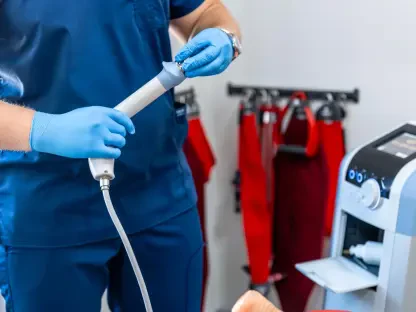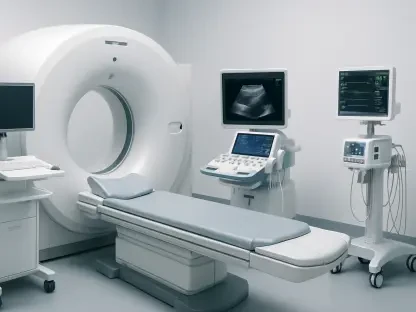In an era where chronic diseases like chronic obstructive pulmonary disease (COPD) place immense pressure on both patients and healthcare systems, telemedicine emerges as a beacon of hope, particularly for those in the severe GOLD stages 3-4. For many individuals recovering from a hospital stay due to an acute exacerbation, maintaining a decent quality of life (QOL) often feels like an uphill battle, compounded by challenges such as limited mobility and access to specialists. Traditional in-person follow-ups, while effective for some, can be burdensome, requiring time, travel, and resources that not all patients can afford. Telemedicine, with its ability to deliver care remotely through digital platforms, offers a transformative alternative. This article delves into the ways this innovative approach is reshaping COPD management, enhancing patient outcomes, and alleviating systemic strains. By examining recent research and real-world implications, the discussion aims to shed light on why telemedicine is becoming a cornerstone of chronic disease care.
Revolutionizing COPD Management with Digital Tools
Telemedicine, defined as the delivery of healthcare services through digital communication technologies like video calls, is rapidly becoming a critical component in managing chronic conditions such as COPD. A notable study published in BMC Pulmonary Medicine provides compelling evidence of its effectiveness, particularly for patients with advanced disease stages. The research compared outcomes between a group receiving remote care and another undergoing standard in-person follow-ups, revealing stark differences in health metrics. By enabling regular check-ins without the need for physical travel, telemedicine addresses a significant barrier for many COPD patients who struggle with mobility or live far from medical facilities. Beyond convenience, this approach ensures continuous monitoring, allowing healthcare providers to intervene promptly when issues arise. This shift toward digital care not only empowers patients but also aligns with broader trends in healthcare, where technology is increasingly harnessed to improve access and efficiency.
The impact of telemedicine on COPD care extends to the very structure of healthcare delivery, offering a scalable solution to a growing public health challenge. As the prevalence of COPD continues to rise globally, hospitals and clinics often find themselves overwhelmed by the demand for services, especially during peak exacerbation seasons. Telemedicine mitigates this strain by reducing the frequency of in-person visits, thereby freeing up valuable resources for more critical cases. Patients benefit from the flexibility of receiving care from the comfort of their homes, which can be particularly reassuring for those who experience anxiety about hospital environments. Additionally, the integration of digital tools fosters a proactive approach to disease management, where data from remote consultations can be used to tailor treatment plans. This personalized focus is a key reason why telemedicine is gaining traction as a sustainable model for long-term care of chronic respiratory conditions.
Enhancing Daily Living for COPD Patients
One of the most profound benefits of telemedicine for COPD patients lies in its capacity to significantly improve quality of life. The BMC Pulmonary Medicine study highlighted a remarkable improvement in the COPD Assessment Test (CAT) scores among participants in the telemedicine group, dropping from a median of 16 to 9 over a three-month period. This decline indicates a notable reduction in symptom burden and better day-to-day functioning, a critical factor for patients dealing with severe respiratory limitations. In comparison, the control group, which relied on traditional in-person care, maintained a higher median score of 18 at the same interval, suggesting less progress in managing daily challenges. The ability to connect with healthcare providers regularly through virtual means ensures that patients receive consistent support, helping them navigate the physical and emotional toll of their condition with greater ease.
Beyond numerical improvements, telemedicine fosters a sense of control and normalcy for COPD patients, which is often disrupted by the unpredictable nature of the disease. Frequent exacerbations can leave individuals feeling helpless, but remote monitoring offers reassurance through ongoing oversight and timely advice. For instance, virtual sessions allow for discussions about symptom changes, medication adjustments, and lifestyle tips without the stress of scheduling and attending clinic visits. This accessibility is particularly vital for those in rural or underserved areas, where specialist care might be hours away. Moreover, the reduction in CAT scores reflects not just physical betterment but also an enhanced mental state, as patients report feeling less overwhelmed by their condition. Telemedicine, by bridging the gap between patients and providers, creates a supportive framework that prioritizes well-being over logistical hurdles, redefining what it means to live with a chronic illness.
Perfecting Inhaler Use Through Virtual Guidance
A cornerstone of effective COPD management is the correct use of inhalers, yet many patients struggle with technique, leading to suboptimal treatment outcomes. Telemedicine addresses this critical issue by providing real-time, personalized feedback during virtual consultations. According to the referenced study, an impressive 91.4% of patients in the telemedicine group demonstrated proper inhaler technique after three months, compared to only 65.7% in the control group receiving standard care. This significant disparity underscores the value of direct observation and correction through video calls, where healthcare providers can visually assess and guide patients step by step. Such interventions are crucial, as improper inhaler use can exacerbate symptoms and increase the risk of hospital readmissions, a common and costly problem in COPD care.
The advantage of telemedicine in refining inhaler technique lies in its ability to offer repeated, tailored instruction without the constraints of in-person scheduling. Many patients, especially older adults, may forget instructions given during a single clinic visit or feel hesitant to ask for clarification. Virtual platforms eliminate these barriers by enabling multiple touchpoints, where providers can reinforce best practices and address individual challenges as they arise. This ongoing dialogue not only boosts confidence in using inhalers correctly but also reduces the likelihood of medication errors that could worsen disease progression. Furthermore, the study’s findings suggest that the visual and interactive nature of telemedicine consultations makes learning more effective, as patients can immediately apply feedback during the session. This hands-on approach transforms a common stumbling block in COPD treatment into an area of strength for many.
Fostering Patient Confidence and Acceptance
Patient satisfaction is a key indicator of telemedicine’s success in COPD management, reflecting its potential to meet emotional as well as clinical needs. The study revealed that 89% of participants in the telemedicine group expressed a preference for continuing with remote care over traditional methods, a testament to its user-friendly nature. Additionally, 83% reported minimal or no anxiety about engaging in virtual consultations, highlighting a level of comfort that is often lacking in hospital settings. This high acceptance rate is largely attributed to the ease of accessing healthcare providers without the physical and emotional burden of travel, which can be particularly daunting for those with severe COPD. The sense of being closely monitored from home provides a layer of security that enhances overall trust in the care process.
Moreover, telemedicine encourages greater engagement by making patients active participants in their health journey. Virtual interactions often feel less formal than clinic visits, fostering open communication where individuals can discuss concerns or symptoms without feeling rushed. This dynamic is especially beneficial for COPD patients who may experience fluctuating conditions and need frequent reassurance or adjustments to their care plan. The ability to connect with providers at a moment’s notice through digital means also alleviates the isolation that chronic illness can bring, as patients feel supported even between scheduled appointments. High satisfaction levels indicate that telemedicine is not just a clinical tool but a means of building stronger patient-provider relationships, which are essential for long-term adherence to treatment protocols and overall mental well-being in managing a debilitating condition.
Alleviating Strain on Healthcare Infrastructure
Telemedicine’s benefits extend beyond individual patients to impact the broader healthcare ecosystem, particularly in addressing the overwhelming burden of chronic diseases like COPD. With the global prevalence of this condition on the rise, medical facilities often grapple with overcrowded schedules and limited resources, especially during periods of frequent exacerbations. By minimizing the need for in-person visits, telemedicine helps redistribute these resources more effectively, ensuring that critical cases receive priority attention. Research, including the study in question, supports the notion that remote care is not only feasible but also cost-effective, reducing overhead costs associated with physical appointments while maintaining, or even improving, patient outcomes.
This systemic relief offered by telemedicine also translates into long-term sustainability for healthcare delivery. As digital platforms become more integrated into routine practice, they pave the way for managing larger patient populations without proportional increases in infrastructure or staffing. For COPD specifically, where follow-up care is essential to prevent readmissions, virtual monitoring ensures that patients receive timely interventions without straining hospital capacities. This efficiency is crucial in regions with limited access to specialists, where telemedicine can connect patients to expertise that would otherwise be out of reach. Ultimately, the adoption of remote care models represents a forward-thinking strategy that balances patient needs with the operational realities of modern healthcare, setting a precedent for how chronic conditions can be managed more equitably and effectively.
Paving the Way for Future Innovations
Reflecting on the strides made in COPD care, telemedicine stands as a pivotal advancement when it demonstrates tangible improvements in patient outcomes. Studies conducted in recent years show that remote interventions lead to better quality of life and inhaler proficiency for those with severe COPD, outpacing results from traditional care models. High satisfaction rates among patients further cement its value, proving that digital solutions can resonate even with demographics often assumed to be resistant to technology. While limitations like short study durations and specific patient focuses are acknowledged, the evidence points to a promising trajectory for telemedicine in chronic disease management.
Looking ahead, the focus should shift toward expanding these findings through broader, more diverse research to validate telemedicine’s efficacy across varied populations. Healthcare systems are encouraged to invest in robust digital infrastructure and training to ensure seamless integration of remote care. Additionally, addressing gaps such as inhaler adherence, which showed improvement but lacked statistical significance, could involve combining telemedicine with enhanced educational tools. As technology continues to evolve, stakeholders must prioritize accessibility and equity, ensuring that all COPD patients, regardless of location or socioeconomic status, can benefit from these innovations. This path forward promises not just better care but a reimagined healthcare landscape.









